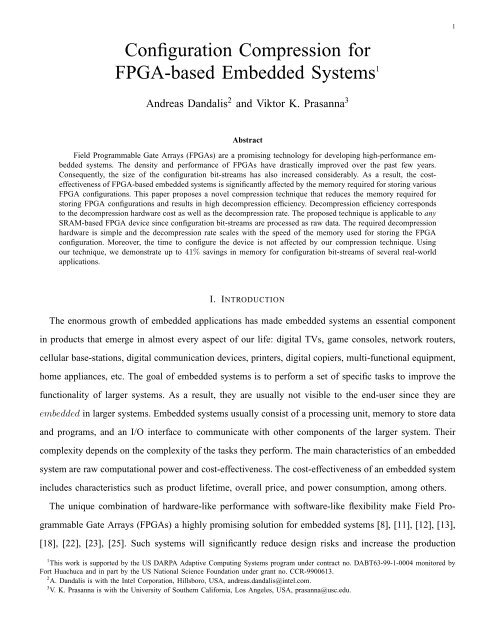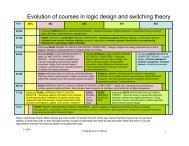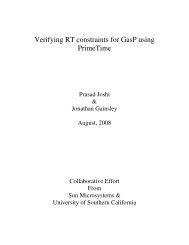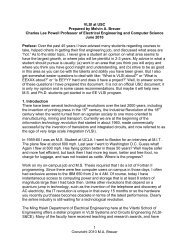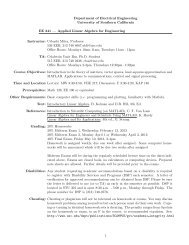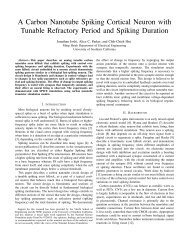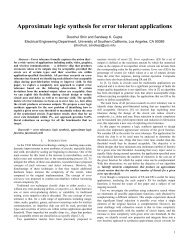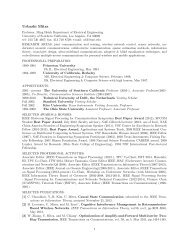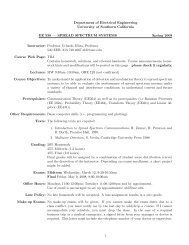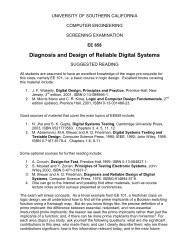Configuration Compression for FPGA-based Embedded Systems1
Configuration Compression for FPGA-based Embedded Systems1
Configuration Compression for FPGA-based Embedded Systems1
You also want an ePaper? Increase the reach of your titles
YUMPU automatically turns print PDFs into web optimized ePapers that Google loves.
<strong>Configuration</strong> <strong>Compression</strong> <strong>for</strong><br />
<strong>FPGA</strong>-<strong>based</strong> <strong>Embedded</strong> Systems 1<br />
Andreas Dandalis 2 and Viktor K. Prasanna 3<br />
Abstract<br />
Field Programmable Gate Arrays (<strong>FPGA</strong>s) are a promising technology <strong>for</strong> developing high-per<strong>for</strong>mance embedded<br />
systems. The density and per<strong>for</strong>mance of <strong>FPGA</strong>s have drastically improved over the past few years.<br />
Consequently, the size of the configuration bit-streams has also increased considerably. As a result, the costeffectiveness<br />
of <strong>FPGA</strong>-<strong>based</strong> embedded systems is significantly affected by the memory required <strong>for</strong> storing various<br />
<strong>FPGA</strong> configurations. This paper proposes a novel compression technique that reduces the memory required <strong>for</strong><br />
storing <strong>FPGA</strong> configurations and results in high decompression efficiency. Decompression efficiency corresponds<br />
to the decompression hardware cost as well as the decompression rate. The proposed technique is applicable to any<br />
SRAM-<strong>based</strong> <strong>FPGA</strong> device since configuration bit-streams are processed as raw data. The required decompression<br />
hardware is simple and the decompression rate scales with the speed of the memory used <strong>for</strong> storing the <strong>FPGA</strong><br />
configuration. Moreover, the time to configure the device is not affected by our compression technique. Using<br />
our technique, we demonstrate up to 41% savings in memory <strong>for</strong> configuration bit-streams of several real-world<br />
applications.<br />
I. INTRODUCTION<br />
The enormous growth of embedded applications has made embedded systems an essential component<br />
in products that emerge in almost every aspect of our life: digital TVs, game consoles, network routers,<br />
cellular base-stations, digital communication devices, printers, digital copiers, multi-functional equipment,<br />
home appliances, etc. The goal of embedded systems is to per<strong>for</strong>m a set of specific tasks to improve the<br />
functionality of larger systems. As a result, they are usually not visible to the end-user since they are<br />
embedded in larger systems. <strong>Embedded</strong> systems usually consist of a processing unit, memory to store data<br />
and programs, and an I/O interface to communicate with other components of the larger system. Their<br />
complexity depends on the complexity of the tasks they per<strong>for</strong>m. The main characteristics of an embedded<br />
system are raw computational power and cost-effectiveness. The cost-effectiveness of an embedded system<br />
includes characteristics such as product lifetime, overall price, and power consumption, among others.<br />
The unique combination of hardware-like per<strong>for</strong>mance with software-like flexibility make Field Pro-<br />
grammable Gate Arrays (<strong>FPGA</strong>s) a highly promising solution <strong>for</strong> embedded systems [8], [11], [12], [13],<br />
[18], [22], [23], [25]. Such systems will significantly reduce design risks and increase the production<br />
1 This work is supported by the US DARPA Adaptive Computing Systems program under contract no. DABT63-99-1-0004 monitored by<br />
Fort Huachuca and in part by the US National Science Foundation under grant no. CCR-9900613.<br />
2 A. Dandalis is with the Intel Corporation, Hillsboro, USA, andreas.dandalis@intel.com.<br />
3 V. K. Prasanna is with the University of Southern Cali<strong>for</strong>nia, Los Angeles, USA, prasanna@usc.edu.<br />
1
volume of the chip. Additionally, the requirements of applications in the in<strong>for</strong>mation-<strong>based</strong> networked<br />
world are changing so rapidly that reconfigurability is possibly the only way to overcome severe time-to-<br />
market requirements.<br />
Typical <strong>FPGA</strong>-<strong>based</strong> embedded systems have <strong>FPGA</strong> devices as their processing unit, memory to<br />
store data and <strong>FPGA</strong> configurations, and an I/O interface to transmit and receive data. <strong>FPGA</strong>-<strong>based</strong><br />
embedded systems can sustain high processing rates while providing a high degree of flexibility required in<br />
dynamically changing environments. <strong>FPGA</strong>s can be reconfigured on demand to support multiple algorithms<br />
and standards. Moreover, by incorporating Run-Time Reconfiguration (RTR), applications consisting of<br />
multiple configurations can be executed [3], [6], [7], [17], [20], [21]. Thus, the degree of system flexibility<br />
strongly depends on the amount of configuration data that can be stored in the field. However, the size<br />
of the configuration bit-stream has increased considerably over the past few years. For example, the size<br />
of the configuration bit-stream of the VIRTEX-II series <strong>FPGA</strong>s, range from 0.4 Mbits to 43 Mbits [24].<br />
In this paper, we propose a novel compression technique to reduce the memory requirements <strong>for</strong> storing<br />
configuration bit-streams in <strong>FPGA</strong>-<strong>based</strong> embedded systems. By compressing configuration bit-streams,<br />
increased configuration data density can be achieved resulting in smaller size memories and/or increased<br />
system flexibility. Smaller size memories and increased system flexibility are essential to enhance the cost-<br />
effectiveness and lifetime of the embedded systems under consideration. Moreover, increased flexibility<br />
can enable the usage of smaller <strong>FPGA</strong> devices in environments that require on-demand computations. A<br />
smaller <strong>FPGA</strong> device that is reconfigured on-demand is more cost-effective compared with a larger <strong>FPGA</strong><br />
device that is configured once <strong>for</strong> all the possible tasks that can be executed during an application.<br />
Using our compression technique, configuration compression occurs off-line. At runtime, decompression<br />
occurs and the decompressed data is fed to the on-chip configuration mechanism to configure the device.<br />
The major per<strong>for</strong>mance requirements of the compression problem are the decompression hardware cost<br />
and the decompression rate. The above requirements distinguish our compression problem from conven-<br />
tional software-<strong>based</strong> applications. We are not aware of any prior work that addresses the configuration<br />
compression problem of <strong>FPGA</strong>-<strong>based</strong> embedded systems with respect to the cost and speed requirements.<br />
Our compression technique is applicable to any SRAM-<strong>based</strong> <strong>FPGA</strong> device and can support both<br />
complete and partial configuration schemes. The proposed technique process configuration bit-streams as<br />
raw data without considering any individual semantics. Such semantics depend on the target <strong>FPGA</strong> device<br />
architecture and the placement/routing tool used <strong>for</strong> application mapping. On the other hand, application-<br />
2
specific computations can lead to hardware structural regularities. Such regularities are explored by our<br />
technique as repeated strings at the bit-stream level.<br />
The required decompression hardware is simple and independent of the configuration <strong>for</strong>mat or char-<br />
acteristics of the configuration mechanism. In addition, the achieved compression ratio is independent of<br />
the decompression hardware and depends only on the entropy of the configuration bit-stream. Finally, the<br />
time to configure an <strong>FPGA</strong> depends only on the data rate of the on-chip configuration mechanism, the<br />
speed of the memory that stores the configuration data, and the size of the configuration bit-stream. The<br />
decompression process does not add any overhead to the configuration time.<br />
The proposed compression technique is <strong>based</strong> on the principles of dictionary-<strong>based</strong> compression al-<br />
gorithms. In addition, a unified-dictionary approach is proposed <strong>for</strong> compressing sets of configurations.<br />
Even though statistical methods can achieve higher compression ratios, we propose a dictionary-<strong>based</strong><br />
approach because statistical methods lead to high decompression hardware cost. Using our technique, we<br />
demonstrate 11 −41% savings in memory <strong>for</strong> configuration bit-streams of several real-world applications.<br />
The configuration bit-streams corresponded to cryptographic and digital signal processing algorithms. Our<br />
target architecture was the VIRTEX series <strong>FPGA</strong>s [24]. The latter choice has been made <strong>for</strong> demonstration<br />
purposes only. Single as well as sets of configuration bit-streams were compressed using our technique.<br />
The size of the configuration bit-streams ranged from 1.7 Mbits to 6.1 Mbits.<br />
An overview of the configuration of SRAM-<strong>based</strong> <strong>FPGA</strong>s is given in Section 2. In Section 3, various<br />
aspects of compression techniques and the constraints imposed by embedded systems are presented. In<br />
Section 4, related work is described. Our novel compression technique is described in Section 5 and<br />
experimental results are demonstrated in Section 6. Finally, in Section 7, possible extensions to our work<br />
are described.<br />
II. <strong>FPGA</strong> CONFIGURATION<br />
An <strong>FPGA</strong> configuration determines the functionality of the <strong>FPGA</strong> device. An <strong>FPGA</strong> device is configured<br />
by loading a configuration bit-stream into its internal configuration memory. An internal controller manages<br />
the configuration memory as well as the configuration data transfer via the I/O interface. Throughout this<br />
paper, we refer to both the configuration memory and its controller as the configuration mechanism. Based<br />
on the technology of the internal configuration memory, <strong>FPGA</strong>s can be permanently configured once or<br />
can be reconfigured in the field. For example, Anti-Fuse technology allows one-time programmability<br />
while SRAM technology allows reprogrammability.<br />
3
In this paper, we focus on SRAM-<strong>based</strong> <strong>FPGA</strong>s. In SRAM-<strong>based</strong> <strong>FPGA</strong>s, the contents of the internal<br />
configuration memory are reset after power-up. As a result, the internal configuration memory cannot be<br />
used <strong>for</strong> storing configuration data permanently. Using partial configuration, only a part of the contents<br />
of the internal configuration memory is modified. As a result, the configuration time can be significantly<br />
reduced compared with the configuration time required <strong>for</strong> a complete reconfiguration. Moreover, partial<br />
configuration can occur at runtime without interrupting the computations that an <strong>FPGA</strong> per<strong>for</strong>ms. SRAM-<br />
<strong>based</strong> <strong>FPGA</strong>s require external devices to initiate and control the configuration process. Usually, the<br />
configuration data is stored in an external memory and an external controller supervises the configuration<br />
process.<br />
The time required to configure an <strong>FPGA</strong> depends on the size of the configuration bit-stream, the clock<br />
rate and the operation mode of the configuration mechanism, and the throughput of the external memory<br />
that stores the configuration bit-stream. Typical sizes of configuration bit-streams range from 0.4 Mbits<br />
to 44 Mbits [1], [2], [24] depending on the density of the device. The clock rate of the configuration<br />
mechanism determines the rate at which the configuration data is delivered to the <strong>FPGA</strong> device. The<br />
configuration data can be transferred to the configuration mechanism serially or in parallel. Parallel modes<br />
of configuration result in faster configuration time. Typical values of data rates <strong>for</strong> <strong>FPGA</strong>s can be as high<br />
as 480 Mbits/sec (i.e., 8 bits × 60 MHz) [1], [2], [24] while some programmable logic cores support<br />
even higher data rates. Thus, the external memory that stores the configuration bit-stream should be able<br />
to sustain the data rate of the configuration mechanism. Otherwise, the memory becomes a per<strong>for</strong>mance<br />
bottleneck and the time to configure the device increases. Such an increase could be critical <strong>for</strong> applications<br />
where an <strong>FPGA</strong> is configured on-demand <strong>based</strong> on run-time parameters.<br />
<strong>Configuration</strong> bit-streams consist of data to be stored in the internal configuration memory as well<br />
as instructions to the configuration mechanism. The data configures the <strong>FPGA</strong> architecture, that is,<br />
the configurable logic blocks, the interconnection network, the I/O pins, etc. The instructions control<br />
the functionality of the configuration mechanism. Typically, instructions are used <strong>for</strong> initializing the<br />
configuration mechanism, synchronizing clock rates, and determining the memory addresses at which<br />
the data will be written. The <strong>for</strong>mat of a configuration bit-stream depends on the characteristics of the<br />
configuration mechanism as well as the characteristics of the <strong>FPGA</strong> architecture. As a result, the bit-stream<br />
<strong>for</strong>mat varies among different vendors or, even among different <strong>FPGA</strong> families of the same vendor.<br />
4
III. COMPRESSION TECHNIQUES: APPLICABILITY & IMPLEMENTATION COST<br />
Data compression has been extensively studied in the past. Numerous compression algorithms have<br />
been proposed to reduce the size of data to be stored or transmitted over a network. The effectiveness of<br />
a compression technique is characterized by the achieved compression ratio, that is, the ratio of the size<br />
of the compressed data to the size of the original data. However, depending on the application, metrics<br />
such as processing rate, implementation cost, and adaptability may become critical per<strong>for</strong>mance issues.<br />
In this section, we will discuss compression techniques and the requirements to be met <strong>for</strong> compressing<br />
<strong>FPGA</strong> configurations in <strong>FPGA</strong>-<strong>based</strong> embedded systems.<br />
In general, a compression technique can be either lossless or lossy. For configuration compression,<br />
the configuration bit-stream should be reconstructed without loss of any in<strong>for</strong>mation and thus, a lossless<br />
compression technique should be used. Otherwise, the functionality of the <strong>FPGA</strong> may be altered or, even<br />
worse, the <strong>FPGA</strong> may be damaged. Lossless compression techniques are <strong>based</strong> on statistical methods<br />
or dictionary-<strong>based</strong> schemes. For any given data, statistical methods can result in better compression<br />
ratios than any dictionary-<strong>based</strong> scheme [19]. Using statistical methods, a symbol in the original data<br />
is encoded with a number of bits proportional to the probability of its occurrence. By encoding the<br />
most frequently-occurring symbols with fewer bits than their binary representation requires, the data is<br />
compressed. The compression ratio depends on the entropy of the original data as well as the accuracy of<br />
the model that is utilized to derive the statistical in<strong>for</strong>mation of the given data. However, the complexity<br />
of the decompression hardware can significantly increase the cost of such an approach. In the context of<br />
embedded systems, dedicated decompression hardware (e.g., CAM memory) is required to align codewords<br />
of different lengths as well as determine the output of a codeword.<br />
In dictionary-<strong>based</strong> compression schemes, single codewords encode variable-length strings of symbols<br />
[19]. The codewords <strong>for</strong>m an index to a phrase dictionary. Decompression occurs by parsing the dictionary<br />
with respect to its index. <strong>Compression</strong> is achieved if the codewords require smaller number of bits<br />
than the strings of symbols that they replace. Contrary to statistical methods, dictionary-<strong>based</strong> schemes<br />
require significantly simpler decompression hardware. Only memory read operations are required during<br />
decompression and high decompression rates can be achieved. There<strong>for</strong>e, in the context of <strong>FPGA</strong>-<strong>based</strong><br />
embedded systems, a dictionary-<strong>based</strong> scheme would result in fairly low implementation cost.<br />
In Figure III, a typical architecture of <strong>FPGA</strong>-<strong>based</strong> embedded systems is shown. These systems consist<br />
of an <strong>FPGA</strong> device(s), memory to store data and <strong>FPGA</strong> configurations, a configuration controller to<br />
5
I/O<br />
<strong>Configuration</strong><br />
Bit-Stream<br />
Memory<br />
Data<br />
Memory<br />
<strong>Configuration</strong><br />
Controller<br />
<strong>FPGA</strong><br />
Fig. 1: <strong>FPGA</strong>-<strong>based</strong> embedded system architecture<br />
supervise the configuration process, and an I/O interface to send and receive data. The configurations are<br />
compressed off-line by a general-purpose computer and the compressed data is stored in the embedded<br />
system. In this work, embedded systems that also include a microprocessor can be considered under<br />
the assumption that the microprocessor is not used <strong>for</strong> compression/decompression (e.g., due to high<br />
utilization by other tasks). Besides the memory requirements <strong>for</strong> the compressed data, additional memory<br />
may be required during decompression (e.g., storing temporary data). However, in the context of embedded<br />
systems, the memory requirements to store temporary data should also be considered.<br />
At runtime, decompression occurs and the original configuration bit-stream is delivered to the <strong>FPGA</strong><br />
configuration mechanism. As a result, the decompression hardware cost and the decompression rate become<br />
major requirements of the compression problem. The decompression hardware cost may affect the cost<br />
of the system. In addition, if the decompression rate can not sustain the data rate of the configuration<br />
mechanism, the time to configure the <strong>FPGA</strong> will increase.<br />
Our compression technique can lead to smaller memory requirements <strong>for</strong> storing <strong>FPGA</strong> data and thus,<br />
reducing the cost of the configuration memory (e.g., configuration-specific system). At the same time, the<br />
power requirements can be reduced since memories of smaller size can be used. In addition, the tight<br />
coupling of configuration memory and <strong>FPGA</strong> devices can result in systems with superior flexibility (e.g.,<br />
system with fixed-size configuration memory). Such flexibility can enable the usage of smaller <strong>FPGA</strong><br />
devices in environments that require on-demand computations.<br />
6
IV. RELATED WORK<br />
Work related to <strong>FPGA</strong> configuration compression has been reported in [9], [10], [16]. In [9], the<br />
proposed technique took advantage of the characteristics of the configuration mechanism of the Xilinx<br />
XC6200 architecture. There<strong>for</strong>e, the technique is applicable only to that architecture. In [10], runlength<br />
compression techniques <strong>for</strong> configurations have been described. Again, the techniques took advantage of<br />
specific characteristics of the Xilinx XC6200 architecture. Addresses were compressed using runlength<br />
encoding while data was compressed using LZ compression (sliding-window method [19]). Dedicated<br />
on-chip hardware was required <strong>for</strong> both methods. A set of configuration bit-streams (2 − 88 Kbits) were<br />
used to fine-tune the parameters of the proposed methods. A 16−bit size window was used in the LZ<br />
implementation. However, as stated in [10], larger size windows impose a fairly high hardware penalty<br />
with respect to the buffer size as well as the supporting hardware. In [16], dictionary-<strong>based</strong> techniques<br />
were developed to reduce the time required to transfer configuration data to VIRTEX series <strong>FPGA</strong>s.<br />
A compressed version of the configuration bit-stream is fed to the configuration circuitry of the <strong>FPGA</strong><br />
and decompression takes place inside the <strong>FPGA</strong>. A modified VIRTEX configuration mechanism was<br />
proposed to support decompression. High compression ratios were reported. However, the time overhead<br />
<strong>for</strong> decompressing the configuration data was not clearly identified.<br />
In [14], [15], dictionary-<strong>based</strong> compression techniques were utilized <strong>for</strong> code minimization in embedded<br />
processors. However, code minimization takes advantage of the semantics of programs <strong>for</strong> Instruction Set<br />
Architecture (ISA) <strong>based</strong> processors and is unlikely to achieve similar results <strong>for</strong> <strong>FPGA</strong> configuration bit-<br />
streams (i.e., raw data). For example, programs can have jumps that require decompression to be per<strong>for</strong>med<br />
not in a sequential manner while configuration bit-streams should be decompressed sequentially. In [15],<br />
a fixed-size dictionary was used <strong>for</strong> compressing programs. The size of the programs was in the order<br />
of hundreds of bits. No detailed in<strong>for</strong>mation was provided regarding the algorithm used to build the<br />
dictionary. The authors mainly focused on tuning the dictionary parameters to achieve better compression<br />
results <strong>based</strong> on the specific set of programs. However, such an approach is unlikely to achieve the<br />
same results <strong>for</strong> <strong>FPGA</strong> configurations where the bit-stream is a data file and not a program <strong>for</strong> ISA-<br />
<strong>based</strong> processors. In addition, Huffman encoding was used <strong>for</strong> compressing the codewords. As a result,<br />
dedicated hardware resources were needed <strong>for</strong> decompressing the codewords. In [14], the dictionary was<br />
built by solving a set-covering problem. The underlying compression model was developed with respect<br />
to the semantics of programs <strong>for</strong> ISA-<strong>based</strong> processors (i.e., control-flow and operational instructions).<br />
7
The size of the considered programs was 0.5-10 Kbits and the achieved compression ratios (i.e., size<br />
of the compressed program as fraction of the original program) were approximately 85-95 %. Since the<br />
technique in [14] was developed <strong>for</strong> code size minimization, it is not fair to make any compression ratio<br />
comparisons with our results.<br />
<strong>Configuration</strong><br />
Bit-Stream<br />
DICTIONARY<br />
INDEX<br />
V. OUR COMPRESSION TECHNIQUE<br />
Reverse<br />
Order<br />
Reverse<br />
Order<br />
INDEX<br />
Dictionary<br />
Construction<br />
DICTIONARY INDEX<br />
Merge common prefix strings<br />
Delete non-referenced nodes<br />
DICTIONARY INDEX<br />
Selectively delete substrings<br />
Selectively delete nodes<br />
LZW<br />
Compact<br />
representation<br />
Heuristic<br />
Fig. 2: Our configuration compression technique<br />
Our compression technique is <strong>based</strong> on the principles of dictionary-<strong>based</strong> compression algorithms.<br />
<strong>Compression</strong> occurs off-line while decompression occurs on-line to reconstruct the original configuration<br />
bit-stream. Even though statistical methods can achieve higher compression ratios [19], we propose a<br />
dictionary-<strong>based</strong> approach because dictionary-<strong>based</strong> schemes lead to simpler and faster decompression<br />
hardware. In our approach, the dictionary corresponds to configuration data and the index corresponds<br />
to the way the dictionary is read in order to reconstruct a configuration bit-stream. In Figure 2, an<br />
overview of our configuration compression technique is shown. The input configuration bit-stream is read<br />
sequentially in the reverse order. Then, the dictionary and the index are derived <strong>based</strong> on the principles of<br />
the well-known LZW compression algorithm [19]. In general, finding a dictionary that results in optimal<br />
compression has exponential complexity [19]. By deleting non-referenced nodes and by merging common<br />
prefix strings, a compact representation of the dictionary is achieved. Finally, a heuristic is applied that<br />
further enhances the dictionary representation and leads to savings in memory. The original configuration<br />
bit-stream can be reconstructed by parsing the dictionary with respect to the index in reverse order. The<br />
achieved compression ratio is the ratio of the total memory requirements (i.e., dictionary and index) to<br />
the size of the bit-stream. In the following, we describe in detail our compression technique as well as<br />
the decompression method.<br />
8
A. Basic LZW Algorithm<br />
The LZW algorithm is an adaptive dictionary encoder, that is, the coding technique of LZW is <strong>based</strong><br />
on the input data already encoded (Algorithm 1). The input to the algorithm is a sequence of binary<br />
symbols. A symbol can be a single bit or a data word. Symbols are processed sequentially. By combining<br />
consecutive symbols, strings are <strong>for</strong>med. In our case, the input is the configuration bit-stream. Moreover,<br />
the bit-length of the symbol determines the way the bit-stream is processed (e.g., bit-by-bit, byte-by-byte).<br />
The main idea of LZW is to replace the longest possible string of symbols with a reference to an existing<br />
dictionary entry. As a result, the derived index consists of pointers to the dictionary.<br />
Input: An input stream of symbols IN.<br />
Output: The dictionary and the index.<br />
dictionary ← input alphabet symbols<br />
S = NULL<br />
repeat<br />
s ← read a symbol from IN<br />
if Ss exists in the dictionary<br />
S ← Ss<br />
else<br />
output the code <strong>for</strong> S<br />
add Ss to the dictionary<br />
S ← s<br />
end<br />
until (all input data is read)<br />
Algorithm 1: The LZW algorithm [20]<br />
In software-<strong>based</strong> applications, only the index is considered in the calculation of the compression ratio.<br />
The main advantage of LZW (and any LZ-<strong>based</strong> algorithm) is that the dictionary can be reconstructed<br />
<strong>based</strong> on the index. As a result, only the index is stored in a secondary storage media or transmitted. The<br />
dictionary is reconstructed on-line and the extra memory required is provided by the “host”. However,<br />
in embedded systems, no secondary storage media is available and the extra required memory has to be<br />
considered in the calculation of the compression ratio. Also, note that the dictionary includes phrases that<br />
are not referenced by its index. This happens because, as compression proceeds, LZW keeps all the strings<br />
that are seen <strong>for</strong> the first time. This is per<strong>for</strong>med regardless of whether these strings will be referenced or<br />
not. This is not a problem in software-<strong>based</strong> applications since the size of the dictionary is not considered<br />
in the calculation of the compression ratio.<br />
9
COMPUTER<br />
B. Compact Dictionary Construction<br />
COMPUTE<br />
R<br />
E<br />
C<br />
O<br />
M<br />
P<br />
U<br />
T<br />
A<br />
T<br />
I<br />
O<br />
N<br />
COMPUTATION<br />
Fig. 3: An illustrative example of our dictionary representation<br />
In our approach, we propose a compact memory representation <strong>for</strong> the dictionary. In general, the<br />
dictionary is a <strong>for</strong>est of suffix trees (i.e., one tree <strong>for</strong> each symbol of the input alphabet). Each string in<br />
a tree is stored in the memory as a singly-linked list. The root of a tree is the head of all the lists in that<br />
tree. Every entry in the memory consists of a symbol and an address to a prefix string and every string<br />
is associated with an entry. A string is read by traversing the corresponding list from the address of its<br />
associated memory entry to the head of the list. Furthermore, dictionary entries that are not referenced<br />
in the index are deleted and not stored in the memory. Finally, common prefix strings are merged as one<br />
string. An example of our dictionary representation is shown in Figure 3. For illustrative purposes, we<br />
consider letters as symbols. The root of the tree is the symbol “C”. Each one of the strings “COMPUTE”,<br />
“COMPUTER”, and “COMPUTATION” is associated with a node. Since the string “COMPUT ” is<br />
a common prefix string, it is only represented once in the memory. In Figure 4, the memory organization <strong>for</strong><br />
storing the dictionary and the index of the above example is shown. The contents of the dictionary entries<br />
are shown in ascending order of their memory address. For each dictionary entry, the corresponding symbol<br />
and the address to a prefix string are shown. The shown index entries correspond to a dictionary memory<br />
address. The memory requirements <strong>for</strong> the dictionary are ndictionary × (datasymbol + ⌈log 2 ndictionary⌉)<br />
bits, where ndictionary is the number of memory entries of the dictionary and datasymbol is the number<br />
of bits required to represent a symbol. Similarly, the memory requirements <strong>for</strong> the index are nindex ×<br />
⌈log 2 ndictionary⌉ bits, where nindex is the number of memory entries of the index.<br />
From the above example, we notice that during decompression, the decompressed strings are delivered in<br />
reverse order. In fact, in software-<strong>based</strong> implementations [19], a stack is used to deliver each decompressed<br />
10
0001<br />
0010<br />
0011<br />
0100<br />
0101<br />
0111<br />
1000<br />
1001<br />
1010<br />
1011<br />
1100<br />
1101<br />
1110<br />
C<br />
O<br />
M<br />
P<br />
U<br />
T<br />
A<br />
T<br />
I<br />
O<br />
N<br />
E<br />
R<br />
Dictionary Index<br />
0000<br />
0001<br />
0010<br />
0011<br />
0100<br />
0101<br />
0111<br />
1000<br />
1001<br />
1010<br />
1011<br />
0111<br />
1101<br />
1100<br />
1110<br />
1101<br />
...<br />
...<br />
...<br />
...<br />
COMPUTATION<br />
COMPUTER<br />
COMPUTE<br />
Fig. 4: An illustrative example of memory organization <strong>for</strong> the dictionary and the index<br />
string in the right order. However, in the considered embedded environment, additional hardware is required<br />
to implement the stack. In addition, the size of the stack should be as large as the length of the longest<br />
string in the dictionary. Moreover, the time overhead to reverse the order of the decompressed strings<br />
would affect the time to configure the <strong>FPGA</strong>. In our scheme, to avoid the use of a stack, we derive the<br />
dictionary after reversing the order of the configuration bit-stream. During decompression, the configuration<br />
bit-stream is reconstructed by parsing the index in the reverse order. In this way, the decompressed strings<br />
are delivered in order and the exact original bit-stream is reconstructed. We have per<strong>for</strong>med several<br />
experiments to examine the impact of compressing a reverse-ordered configuration bit-stream instead of<br />
the original one. Our experiments suggest that the memory requirements <strong>for</strong> both the dictionary and the<br />
index are very close to each other in both cases (i.e., variation less than ±1%).<br />
C. Enhancement of the Dictionary Representation<br />
After deriving the dictionary and its index, we reduce the memory requirements of the dictionary by<br />
selectively decomposing strings in the dictionary. In the following, a prefix string corresponds to a path<br />
from any node up to the tree root. Similarly, a suffix string corresponds to a path from a leaf node up to<br />
any node. Finally, a substring corresponds to a path between any two arbitrary nodes.<br />
The main idea is to replace frequently-occurring substrings by a new or an existing substring. As a result,<br />
while memory savings can be achieved <strong>for</strong> the dictionary, additional codewords are also introduced leading<br />
to index expansion. For example, consider the prefix strings “COMPUTER” and “QUALCOM” (see<br />
Figure 5). Again, <strong>for</strong> illustrative purposes, we consider letters as symbols. Since “COM” is a common<br />
11
Input: A dictionary Din and an index Iin.<br />
Output: Enhanced dictionary Dtemp and index Itemp.<br />
STRINGS={suffix strings in Din containing nodes that<br />
are pointed at by only one suffix string}<br />
U={si: siǫSTRINGS ∧ (if i = j ⇒ si = sj)}<br />
Ul={si: siǫU ∧ length(si)=l}<br />
/* L = maxlength(si)<br />
/* datadictionary: word-length <strong>for</strong> the dictionary memory<br />
/* dataindex: word-length <strong>for</strong> the index memory<br />
/* ni: node of si with the highest distance from a leaf node<br />
/* ti: # of xǫSTRINGS : x = si<br />
/* ci: # of times ni is referenced by the index<br />
if ∃ prefix string xǫDin : x = si<br />
ai = 0<br />
else<br />
ai = 1<br />
end<br />
cost(si) = (ti − ai) ∗ (datadictionary) − ci ∗ dataindex<br />
Sdelete = NULL<br />
<strong>for</strong> l = 1..L<br />
Stemp = NULL<br />
∀si : siǫ{Ul ∪ U}<br />
if cost(si) ≥ 0<br />
Sdelete = Sdelete ∪ {si}<br />
else<br />
Stemp = Stemp ∪ Ul∪ {xǫSTRINGS : si ❂ x}<br />
end<br />
U = U − Stemp<br />
end<br />
delete {xǫSTRINGS : x = y ∧ yǫSdelete}<br />
Snew = {new prefix strings that replace<br />
the deleted suffix strings}<br />
Dtemp = Din− {deleted substrings} ∪Snew<br />
Itemp = {restore Iin due to deleted substrings}<br />
Algorithm 2: Our Heuristic: Phase 1.<br />
substring, by storing it in the memory only once, the dictionary size can be reduced. However, one<br />
additional codeword is required <strong>for</strong> “COMPUTER” since it is decomposed in two substrings (i.e.,<br />
“COM” and “PUTER”). In general, the problem of decomposing substrings that can result in maximum<br />
savings in memory has exponential complexity.<br />
In the following, a 2-phase greedy heuristic is described that selectively decomposes substrings to<br />
achieve overall memory savings. A bottom-up approach is used that prunes the suffix trees starting from<br />
the leaf nodes and replaces deleted suffix strings by new (or existing) prefix strings. We concentrate only<br />
on suffix strings that include nodes pointed at by only one suffix string. Otherwise, the suffix string extends<br />
over large number of prefix strings resulting in lower possibility <strong>for</strong> potential savings in memory. Using<br />
12
Input: Dtemp and Itemp from Algorirthm 2.<br />
Output: Enhanced dictionary Denh and index Ienh.<br />
Algorithm 3: Our Heuristic: Phase 2.<br />
N = {ni : niǫsi ∧ siǫ{Dtemp ∩ STRINGS}}<br />
/* STRINGS is the same set of strings as in Algorithm 2<br />
/* ni: dictionary node<br />
cost(ni) = # of times ni is referenced by the index<br />
depth(ni) = distance from a leaf node<br />
sort N in terms of depth(ni) /* ascending order<br />
sort ni of same depth in terms of cost(ni) /* ascending order<br />
Nm = NULL<br />
ntemp =| Dtemp | −2 ⌈log 2 |Dtemp|⌉−1 /* | ∗ |= # of nodes in ∗<br />
while | N |≥ ntemp<br />
repeat<br />
mark consecutive nodes in N<br />
with respect to sorting<br />
Nm = {marked nodes}<br />
until (# of marked nodes − cost(ni) − α == ntemp)<br />
/* cost(ni): summation of costs of the marked nodes<br />
/* α: # of nodes required to replace suffix strings that<br />
/* will be deleted if marked nodes are deleted<br />
if (deletion of marked nodes results in overall savings)<br />
N = N − Nm<br />
| Dtemp |← 2 ⌈log 2 |Dtemp|⌉−1<br />
ntemp ← 2⌈log2 |Dtemp|⌉−1<br />
else<br />
BREAK<br />
end<br />
end<br />
delete {marked nodes}<br />
Snew ={new prefix strings that replace<br />
the deleted suffix strings}<br />
Denh = Dtemp − {marked nodes} ∪Snew<br />
Ienh = {restore Itemp due to deleted substrings}<br />
our heuristic, 80 − 85% of the nodes in all suffix trees were examined <strong>for</strong> the bit-streams considered in<br />
our experiments (see Section VI).<br />
In the first phase, we delete suffix strings that can lead to potential savings in memory (see Algorithm 2).<br />
Initially, we identify repeated suffix strings that appear across all the suffix trees of the dictionary. As<br />
mentioned earlier, the number of suffix trees in the dictionary equals the number of symbols of the<br />
input alphabet. For each distinct suffix string si, the potential savings in memory cost(si) are computed.<br />
The cost(si) depends on the potential savings in dictionary memory and the potential index expansion<br />
assuming that si is deleted from all the suffix trees. Only suffix strings si with non-negative cost(si) are<br />
deleted. By reducing the dictionary size, the number of bits that is required to address the dictionary<br />
13
QUALCOM<br />
M<br />
O<br />
C<br />
L<br />
A<br />
U<br />
Q<br />
COMPUTER<br />
R<br />
E<br />
T<br />
U<br />
P<br />
M<br />
O<br />
C<br />
QUALCOM<br />
Fig. 5: An illustrative example of enhancing the dictionary representation<br />
(i.e., ⌈log 2 ndictionary⌉) can decrease too. As a result, the word-length of both the dictionary and index<br />
memories can decrease resulting in further savings in memory.<br />
In the second phase, we selectively delete individual nodes of the suffix trees in order to decrease the<br />
number of bits required to address the dictionary (see Algorithm 3). The deletion of nodes results in<br />
index expansion. However, the memory requirements due to the increase of index size can be potentially<br />
amortized by the decrease of the word-length of both the dictionary and the index memories. The goal is<br />
to reduce the dictionary size while introducing minimum number of new codewords. Initially, nodes ni<br />
of the same distance across all the suffix trees are sorted with respect to the number of codeword splits<br />
cost(ni) (i.e., number of new codewords introduced if the node will be deleted). Then, starting from the<br />
leaf nodes, we mark individual nodes according to their cost(ni). A marked node is eligible to be deleted.<br />
Nodes with smaller number of codeword splits are marked first. We continue to mark nodes until we<br />
achieve a 1 bit savings in addressing the dictionary. If the index expansion results in increasing the total<br />
memory requirements, the marked nodes are not deleted and the procedure is terminated. Otherwise, the<br />
marked nodes are deleted and the procedure is repeated.<br />
D. <strong>Configuration</strong> Decompression<br />
Decompression occurs at power-up or at runtime. The original configuration bit-stream is reconstructed<br />
by parsing the dictionary with respect to the index. As shown in Figure 6(b), the contents of the index<br />
(i.e., codewords) are read sequentially. A codeword corresponds to an address to the dictionary memory.<br />
For each codeword, all the symbols of the associated string are read from the dictionary memory and then<br />
the next codeword is read. A comparator is used to decide if the output data of the dictionary memory<br />
corresponds to a root node, that is, all the symbols of a string have been read. Depending on the output of<br />
the comparator, a new codeword is read or the last-read pointer is used to address the dictionary memory.<br />
M<br />
O<br />
C<br />
L<br />
A<br />
U<br />
Q<br />
COM<br />
PUTER<br />
R<br />
E<br />
T<br />
U<br />
P<br />
14
As a result, the decompression rate scales with the speed of the memory used <strong>for</strong> storing the dictionary.<br />
Dictionary<br />
Memory<br />
<strong>Configuration</strong><br />
Bit-Stream<br />
Memory<br />
address<br />
data<br />
(a) Conventional read of the configuration bit-stream<br />
address<br />
data<br />
?=0<br />
M UX<br />
pointer<br />
symbol<br />
data<br />
Index<br />
Memory<br />
address<br />
(b) Decompression-<strong>based</strong> reconstruction of the configuration bit-stream<br />
Counter<br />
to <strong>FPGA</strong><br />
configuration<br />
mechanism<br />
Counter<br />
to <strong>FPGA</strong><br />
configuration<br />
mechanism<br />
Fig. 6: Our configuration decompression approach<br />
In Figure 6, both a typical scheme and our compression-<strong>based</strong> scheme <strong>for</strong> storing and reading the<br />
configuration bit-stream are shown. Typically, the configuration bit-stream is stored in memory. It is<br />
important to deliver the bit-stream sequentially otherwise the configuration mechanism will not be ini-<br />
tialized correctly and the configuration process will fail. Depending on the configuration mode, data is<br />
delivered serially or in parallel. In our scheme, the only hardware overhead introduced is a comparator<br />
and a multiplexer. The output of the decompression process is identical to the data delivered by the<br />
conventional scheme. Moreover, the data rate <strong>for</strong> delivering the configuration data is the same <strong>for</strong> both<br />
the schemes and depends only on the memory bandwidth. The decompression process does not add any<br />
time overhead to the configuration time. Moreover, the hardware cost is minimal compared with the<br />
conventional scheme.<br />
VI. EXPERIMENTS & COMPRESSION RESULTS<br />
Our configuration compression technique was applied to configuration bit-streams of several real-world<br />
applications. The target architecture was the VIRTEX series <strong>FPGA</strong>s [24]. VIRTEX <strong>FPGA</strong>s have been<br />
chosen <strong>for</strong> demonstration purposes only. For mapping onto the VIRTEX devices, we used the Foundation<br />
15
TABLE I: <strong>Compression</strong> ratios <strong>for</strong> single configurations<br />
<strong>Configuration</strong><br />
Bit-stream size<br />
(bits) LZW<br />
<strong>Compression</strong> ratio<br />
Compact Heuristic LZW Lower Bound<br />
MARS 3608000 179 % 96 % 82 % 73 %<br />
RC6 2546080 119 % 69 % 59 % 48 %<br />
Rijndael 3608000 198 % 104 % 89 % 81 %<br />
Serpent 2546080 165 % 95 % 79 % 67 %<br />
Twofish 6127712 186 % 103 % 86 % 76 %<br />
FFT-256 1751840 140 % 85 % 68 % 56 %<br />
FFT-1024 1751840 159 % 89 % 72 % 64 %<br />
4 × FIR-256 1751840 180 % 97 % 80 % 73 %<br />
FIR-1024 1751840 177 % 96 % 79 % 71 %<br />
TABLE II: Dictionary and Index memory requirements <strong>for</strong> single configurations<br />
<strong>Configuration</strong><br />
Dictionary<br />
memory requirements & word-length (bits)<br />
Index<br />
memory requirements & word-length (bits)<br />
LZW Compact Heuristic LZW Compact Heuristic<br />
MARS 3827070 26 1116912 24 172032 21 2644920 18 2351040 16 2796586 13<br />
RC6 1811575 25 667575 23 172032 21 1227536 17 1083120 15 1344564 13<br />
Rijndael 4231448 26 1149840 24 172032 21 2924874 18 2599888 16 3055949 13<br />
Serpent 2511275 25 826152 24 172032 21 1703332 17 1603136 16 1845688 13<br />
Twofish 6746558 26 1919550 25 360448 22 4666104 18 4406876 17 4913398 14<br />
FFT-256 1479408 24 564144 23 81920 20 982192 16 920805 15 1107396 12<br />
FFT-1024 1657900 25 574034 23 81920 20 1123037 17 990915 15 1181964 12<br />
4 × FIR-256 1883900 25 575897 23 81920 20 1276717 17 1126515 17 1330044 12<br />
FIR-1024 1849725 25 580612 23 81920 20 1253478 17 1106010 15 1303416 12<br />
Series v2.1i software development tool. Each application was mapped onto the smallest VIRTEX device<br />
that met the area requirements of the corresponding implementation. We have purposely used the smallest<br />
possible array in order to achieve high hardware utilization and avoid trivial cases such as large sequences<br />
of zeros. Our results indicated that such cases were indeed avoided and no ”magic” words were found.<br />
The derived suffix trees were very flat structures of small height. All bit-streams used corresponded to<br />
complete configurations. However, this is not a limitation of our approach since it can also handle partial<br />
configuration bit-streams. The size of the configuration bit-streams ranged from 1.7 Mbits to 6.1 Mbits.<br />
In Table I, the configuration bit-stream sizes <strong>for</strong> each implementation are shown.<br />
The considered configuration bit-streams corresponded to implementations of cryptographic and signal<br />
processing algorithms. The cryptographic algorithms were the final candidates of the Advanced Encryption<br />
Standard (AES): MARS, RC6, Rijndael, Serpent, and Twofish. Their implementations included a<br />
key-scheduling unit, a control unit, and one round of the cryptographic core that was used iteratively.<br />
Implementation details of the AES algorithms can be found in [5]. We have also implemented digital<br />
signal processing algorithms using the logic cores provided with the Foundation 2.1i software tool [24].<br />
16
TABLE III: <strong>Compression</strong> ratios <strong>for</strong> sets of configurations<br />
<strong>Configuration</strong>s<br />
Bit-streams size<br />
(bits) LZW<br />
<strong>Compression</strong> ratio<br />
Compact Heuristic Baseline<br />
MARS, Rijndael 2 × 3608000 181 % 97 % 85 % 85.50 %<br />
RC6, Serpent 2 × 2546080 136 % 76 % 68 % 69.00 %<br />
FFT-256, FFT-1024,<br />
4 × FIR-256, FIR-1024<br />
4 × 1751840 142 % 84 % 71 % 74.75 %<br />
TABLE IV: Dictionary and Index memory requirements <strong>for</strong> sets of configurations<br />
<strong>Configuration</strong>s<br />
Dictionary<br />
memory requirements & word-length (bits)<br />
Index<br />
memory requirements & word-length (bits)<br />
LZW Compact Heuristic LZW Compact Heuristic<br />
MARS, Rijndael 7676856 27 2193250 25 360448 22 5397406 19 4829258 17 5772508 14<br />
RC6, Serpent 4092062 26 1376568 24 360448 22 2828394 18 2514128 16 3095974 14<br />
FFT-256, FFT-1024,<br />
4 × FIR-256, FIR-1024<br />
5889468 26 2063875 25 360448 22 4072788 18 3846522 17 4648700 14<br />
A 1024− and a 512− point complex FFT were implemented that were able to per<strong>for</strong>m IFFT too. In<br />
addition, four 256−tap FIR filters were mapped onto the same device. In this implementation, all filters<br />
can process data concurrently. Finally, a 1024−tap FIR filter was also implemented.<br />
The configuration bit-streams were processed byte − by − byte during compression, that is, the symbol<br />
<strong>for</strong> the dictionary entries was chosen to be an 8-bit word. As a result, the decompressed data is delivered as<br />
8-bit words and, thus, parallel modes of configuration can be supported. Note that the maximum number<br />
of bits used in parallel modes of configuration is typically 8 bits [1], [2], [24]. If the configuration mode<br />
requires less than 8 bits (e.g., serial mode), an 8−to−n bit converter can be used, where n is the number<br />
of bits required by the configuration mode. Note also that our heuristic can be applied <strong>for</strong> any symbol<br />
length. However, in this work, <strong>for</strong> each configuration bit-stream, we do not attempt to find the optimal<br />
bit-length <strong>for</strong> the symbol that leads to the best compression results. Our goal is to optimize a given<br />
dictionary structure regardless the symbol length.<br />
A. Single <strong>Configuration</strong>s<br />
The compression results <strong>for</strong> single configurations are shown in Tables I and II. The results are organized<br />
with respect to the optimization stages of our technique (see Figure 2). The results shown <strong>for</strong> LZW<br />
correspond to the construction of the dictionary and the index using the LZW algorithm. The only<br />
difference compared with Figure 2 is that the LZW results include the optimization of merging common<br />
prefix strings in the dictionary. Hence, the results shown <strong>for</strong> Compact correspond to the deletion of<br />
the non-referenced nodes in the dictionary. Finally, the results shown <strong>for</strong> Heuristic correspond to the<br />
17
optimizations per<strong>for</strong>med by our heuristic and are also the overall results of our compression technique.<br />
In Table I, the achieved compression ratios are shown. The compression ratio is the ratio of the total<br />
memory requirements (i.e., memory to store dictionary and index) to the bit-stream size. In addition,<br />
in Table I, lower bounds on the compression ratios are shown. For our compression technique, the<br />
lower bound <strong>for</strong> each bit-stream corresponds to the entropy of the bit-stream with respect to the LZW<br />
compression algorithm. As mentioned in Section 3, the compression ratio is affected by the entropy of the<br />
data to be compressed [19]. The critical metric is the entropy of the LZW model that allows comparing<br />
the per<strong>for</strong>mance of our heuristic with respect to the model used to derive the dictionary. As a result, the<br />
IID model is misleading <strong>for</strong> this case since it considers all symbols as independent data while LZW model<br />
is <strong>based</strong> on strings of symbols. We have calculated the lower bound by dividing the index size derived<br />
using LZW by the bit-stream size. There<strong>for</strong>e, the lower bound corresponded to the compression ratio that<br />
can be achieved by LZW <strong>for</strong> software-<strong>based</strong> applications (assuming 8 − bit symbols).<br />
In Table II, the compression results are shown in terms of the memory requirements. The memory<br />
requirements <strong>for</strong> the dictionary are ndictionary ×(8+⌈log 2 ndictionary⌉) bits, where ndictionary is the number<br />
of memory entries of the dictionary. Similarly, the memory requirements <strong>for</strong> the index are nindex ×<br />
⌈log 2 ndictionary⌉ bits, where nindex is the number of memory entries of the index and ⌈log 2 ndictionary⌉ is<br />
the number of bits required to address the dictionary.<br />
LZW In software-<strong>based</strong> applications, only the index is considered in the calculation of the compression<br />
ratio. In addition, statistical encoding schemes are utilized <strong>for</strong> further compressing the index. As a<br />
result, in typical LZW applications, superior compression ratios (i.e., 10 − 20 %) have been achieved<br />
by using commercially available software programs (e.g., compress, gzip). However, such commercial<br />
programs are not applicable to our compression problem. As discussed earlier, in the context of embedded<br />
environments, both the dictionary and the index are considered in the calculation of the compression ratio.<br />
The size of the derived dictionaries was comparable to the size of the original bit-streams. There<strong>for</strong>e,<br />
negative compression occurred, that is, the memory requirements <strong>for</strong> the dictionary and the index were<br />
greater than the bit-stream size.<br />
Compact By deleting the non-referenced nodes in the dictionary, the number of the dictionary entries<br />
was reduced by a factor of 2.4 − 3.4. As a result, the number of bits required to address the dictionaries<br />
was also reduced by 1 to 2 bits affecting the word-length of both the dictionary and the index memories<br />
accordingly. Compared with the LZW results, the memory requirements <strong>for</strong> the dictionaries were reduced<br />
18
y a factor of 2.5 − 3.7. In addition, the memory requirements <strong>for</strong> the indices were also reduced by<br />
6 − 13 % even though the number of codewords remained the same. Overall, the compression ratios<br />
achieved at this optimization stage were 69 − 104 %.<br />
Heuristic Finally, the overall savings in memory were further improved by our heuristic. The goal of our<br />
heuristic was to reduce the size of the dictionary at the expense of the index expansion. Indeed, compared<br />
to the Compact results, the dictionary entries were reduced by a factor of 2.9 − 6.2 while the number of<br />
codewords was increased by 35−50 %. The number of bits required to address the dictionary was reduced<br />
by 2 to 3 bits affecting the word-length of both the dictionary and the index memories accordingly. As a<br />
result, even though the number of codewords was increased, the total memory requirements were reduced.<br />
Compared with the Compact results, the memory requirements of the dictionaries were further reduced<br />
by a factor of 3.2−7.1 while the memory requirement of the indices were increased by 18−40 %. Overall,<br />
the compression ratios achieved at this optimization stage were 59 − 89 %. Our heuristic improved the<br />
compression ratios provided by the Compact results by 14 − 20 %.<br />
Considering the compression ratios achieved by LZW and the lower bounds on them, our compression<br />
technique per<strong>for</strong>ms well. The improvements over the LZW results were significant. On the average, our<br />
technique reduced the dictionary memory requirements by 94.5 % while the index memory requirements<br />
were increased by 11.5 %. As a result, our compression results were close to the lower bounds. On the<br />
average, our compression ratios were higher than the lower bounds by 14.5 %. Overall, our compression<br />
technique reduced the memory requirements of the configuration bit-streams by 0.35 − 1.04 Mbits. The<br />
savings in memory corresponded to 11−41 % of the original bit-streams. Given a fixed-size configuration<br />
memory, memory savings enhance the flexibility of a system since more bit-streams can fit in the<br />
configuration memory. On the other hand, in the case of designing an application-specific system with<br />
specific configurations, the savings in memory are related to the cost of the system. The absolute value<br />
<strong>for</strong> savings in memory will determine the smallest memory size that can be used. Inevitably, the memory<br />
size availability also affect the overall cost savings.<br />
B. Sets of <strong>Configuration</strong>s<br />
Our technique can be extended to compress a set of configurations by incorporating a unified-dictionary<br />
approach. The proposed approach differs from our configuration compression technique (see Figure 2)<br />
only with respect to the way the dictionary is constructed. Instead of constructing multiple dictionaries<br />
by processing the configuration bit-streams independently, the bit-streams are processed in a sequence<br />
19
y sharing the same dictionary. The LZW algorithm (see Algorithm 1) is applied to each configuration<br />
bit-stream without initializing the dictionary. Every time LZW is called, it uses the dictionary that was<br />
derived by the preceding call. The derived indices are grouped in one index <strong>for</strong> facilitating the processing<br />
through the remaining stages of our compression technique (see Figure 2).<br />
The goal of the unified-dictionary approach is to construct a single dictionary <strong>for</strong> multiple configurations<br />
in order that the world-length of the index memory will be the same across different configurations. As<br />
a result, a simple memory organization will be required <strong>for</strong> decompression, which is identical to the<br />
one shown in Figure 6(b). On the contrary, if the configuration bit-streams are processed independently<br />
(baseline 4 ), a more complex memory organization will be required that consists of multiple memory<br />
modules of various word-lengths. Furthermore, if the dictionaries obtained by the baseline approach are<br />
grouped to <strong>for</strong>m a single dictionary, the compression ratio would increase due to the increase in the<br />
number of bits required to address the dictionary entries.<br />
In Tables III and IV, the achieved compression ratios and the dictionary and index memory requirements<br />
are shown. <strong>Configuration</strong>s corresponding to the same <strong>FPGA</strong> device are grouped together since it is<br />
uncommon <strong>for</strong> <strong>FPGA</strong> systems to utilize different <strong>FPGA</strong> devices as computing nodes (except <strong>FPGA</strong><br />
devices that are used <strong>for</strong> control). Clearly, besides resulting in simple memory organization, the proposed<br />
approach achieves better compression ratios than the baseline approach. This happens because the increase<br />
of the number of bits required to address the dictionary entries is amortized by the decrease of the number<br />
of index entries. The number of index entries decreases due to the fact that, after the first call to LZW, the<br />
dictionary is not initialized with the alphabet symbols but, it already contains some strings. There<strong>for</strong>e, <strong>for</strong><br />
larger number of configuration bit-streams, a larger decrease in the number of index entries is expected.<br />
Compared with the baseline approach, <strong>for</strong> {MARS, Rijndael}, {RC6, Serpent}, and {FFT-256, FFT-<br />
1024, 4 × FIR-256}, the number of index entries decreases by 8.41%, 9.89%, and 19.06% respectively.<br />
Be<strong>for</strong>e applying our heuristic (see Figure 2), the number of dictionary entries is decreased by 7 − 17%<br />
compared with the baseline approach. This happens because common entries among different dictionaries<br />
are replaced by a single entry in the unified dictionary. However, after applying our heuristic, the number<br />
of dictionary entries is the same <strong>for</strong> both the approaches.<br />
4 For comparison purposes, in the remainder of this section, the solution to processing the configuration bit-streams independently is referred<br />
as baseline.<br />
20
VII. CONCLUSIONS<br />
In this paper, a novel configuration compression technique was proposed. Our goal was to reduce the<br />
memory required to store configurations in <strong>FPGA</strong>-<strong>based</strong> embedded systems and achieve high decom-<br />
pression efficiency. Decompression efficiency corresponds to the decompression hardware cost as well as<br />
the decompression rate. Although data compression has been extensively studied in the past, we are not<br />
aware of any prior work that addresses configuration compression <strong>for</strong> <strong>FPGA</strong>-<strong>based</strong> embedded systems<br />
with respect to the cost and speed requirements. Our compression technique is applicable to any SRAM-<br />
<strong>based</strong> <strong>FPGA</strong> device since it does not depend on specific features of the configuration mechanism. The<br />
configuration bit-streams are processed as raw data without considering individual semantics. As a result,<br />
both complete and partial configuration schemes can be supported. The required decompression hardware<br />
is simple and does not depend on the individual semantics of configuration bit-streams or specific features<br />
of the configuration mechanism. Moreover, the decompression process does not affect the time to configure<br />
the device and the decompression rate scales with the speed of the memory used <strong>for</strong> storing the dictionary.<br />
Using our technique, we have demonstrated 11 − 41 % savings in memory <strong>for</strong> various configuration bit-<br />
streams of real-world applications. Considering the lower bounds derived <strong>for</strong> the compression ratios, the<br />
achieved compression ratios were higher than the lower bounds by 14.5 % on the average. In addition,<br />
a unified-dictionary approach was proposed <strong>for</strong> compressing sets of configurations. Such an approach<br />
achieves better compression ratios than compressing the configurations independently while leading to a<br />
simple memory organization that does not require multiple memory modules of different word-length.<br />
Future work includes the development of a skeleton-<strong>based</strong> approach <strong>for</strong> our compression technique.<br />
A skeleton corresponds to the correlation among a set of configuration bit-streams. By removing the<br />
data redundancy of the skeleton in the bit-streams, savings in memory can be achieved. Given a set<br />
of configurations, we plan to address the problem of deriving a skeleton in order to reduce the size of<br />
individual indices. Related problems are addressed in [4].<br />
The work reported here is part of the USC MAARCII project (http://maarcII.usc.edu). This<br />
project is developing novel mapping techniques to exploit dynamic reconfiguration and facilitate run-time<br />
mapping using configurable computing devices and architectures.<br />
[1] Altera PLD Devices, http://www.altera.com<br />
[2] Atmel <strong>FPGA</strong>, http://www.atmel.com<br />
REFERENCES<br />
21
[3] K. Bondalapati, P. Diniz, P. Duncan, J. Granacki, M. Hall, R. Jain, and H. Ziegler, DEFACTO: A Design Environment <strong>for</strong> Adaptive<br />
Computing Technology, Reconfigurable Architectures Workshop, April 1999.<br />
[4] A. Dandalis, Dynamic Logic Synthesis <strong>for</strong> Reconfigurable Devices, PhD Thesis, Dept. of Electrical Engineering, University of Southern<br />
Cali<strong>for</strong>nia, December 2001.<br />
[5] A. Dandalis, V. K. Prasanna, and J. D. P. Rolim, A Comparative Study of Per<strong>for</strong>mance of AES Final Candidates Using <strong>FPGA</strong>s,<br />
Workshop on Cryptographic Hardware and <strong>Embedded</strong> Systems, August 2000.<br />
[6] O. Diessel and H. ElGindy, On dynamic task scheduling <strong>for</strong> <strong>FPGA</strong>-<strong>based</strong> systems, International Journal of Foundations of Computer<br />
Science, Special Issue on Scheduling: Theory and Applications, 12(5), pp. 645 - 669, October 2001.<br />
[7] J.G. Eldredge and B.L. Hutchings, Run-Time Reconfiguration: A Method <strong>for</strong> Enhancing the Functional Density of SRAM-Based <strong>FPGA</strong>s,<br />
Journal of VLSI Signal Processing, Vol. 12(1), pp. 67-86, January 1996.<br />
[8] R. Hartenstein, J. Becker, M. Herz, and U. Nageldinger, An <strong>Embedded</strong> Accelerator <strong>for</strong> Real World Computing, IFIP International<br />
Conference on Very Large Scale Integration, August 1997.<br />
[9] S. Hauck, Z. Li, and E. J. Schwabe, <strong>Configuration</strong> <strong>Compression</strong> <strong>for</strong> the Xilinx XC6200 <strong>FPGA</strong>, IEEE Transactions on Computer-Aided<br />
Design of Integrated Circuits and Systems, Vol. 18, No. 8, pp. 1107-1113, August 1999.<br />
[10] S. Hauck and W. D. Wilson, Runlength <strong>Compression</strong> Techniques <strong>for</strong> <strong>FPGA</strong> <strong>Configuration</strong>s, IEEE Symposium on Field-Programmable<br />
Custom Computing Machines, April 1999.<br />
[11] R. D. Hudson, D. I. Lehn, and P. Athanas, A Run-Time Reconfigurable Engine <strong>for</strong> Image Interpolation, IEEE Symposium on Field-<br />
Programmable Custom Computing Machines, April 1998.<br />
[12] H. Kim, A. K. Somani, and A. Tyagi, A Reconfigurable Multi-function Computing Cache Architecture, IEEE Transactions on Very<br />
Large Scale Integration Systems, Volume 9(4), pp. 509-523, August 2001.<br />
[13] M. Klimesh, V. Stanton, and D. Watola, Hardware Implementation of a Lossless Image <strong>Compression</strong> Algorithm Using a Field<br />
Programmable Gate Array, The Telecommunications and Mission Operations Progress Report, Jet Propulsion Laboratory, Cali<strong>for</strong>nia<br />
Institute of Technology, February 2001.<br />
[14] S. Laio, S. Devadas, and K. Keutzer, A Text-<strong>Compression</strong>-Based Method <strong>for</strong> Code Size Minimization in <strong>Embedded</strong> Systems, ACM<br />
Transactions on Design Automation of Electronic Systems, Vol. 4, No. 1, pp. 12-38, January 1999.<br />
[15] C. Lefurgy, P. Bird, I-C. Cheng, and T. Mudge, Improving Code Density Using <strong>Compression</strong> Techniques, 29th Annual IEEE/ACM<br />
Symposium on Microarchitecture, December 1997.<br />
[16] Z. Li and S. Hauck, <strong>Configuration</strong> <strong>Compression</strong> <strong>for</strong> Virtex <strong>FPGA</strong>s, IEEE Symposium on Field-Programmable Custom Computing<br />
Machines, April 2001.<br />
[17] R. Maestre, F.J. Kurdahi, N. Bagerzadeh, H. Singh, R. Hermida, and M. Fernandez, Kernel Scheduling in Reconfigurable Computing,<br />
Design, Automation and Test in Europe Conference, March 1999.<br />
[18] J. T. McHenry, P. W. Dowd, F. A. Pellegrino, T. M. Carrozzi, and W. B. Cocks, An <strong>FPGA</strong>-<strong>based</strong> coprocessor <strong>for</strong> ATM firewalls, IEEE<br />
Symposium on Field-Programmable Custom Computing Machines, April 1997.<br />
[19] M. Nelson and J-L. Gaily, The Data <strong>Compression</strong> Book, M&T Books, New York, 1996.<br />
[20] S. Ogrenci-Memik, E. Bozorgzadeh, R. Kastner, and M. Sarrafzadeh, A Super-Scheduler <strong>for</strong> <strong>Embedded</strong> Reconfigurable Systems,<br />
International Conference on Computer-Aided Design, November 2001.<br />
[21] N. Shirazi, W. Luk, and P.Y.K. Cheung, Framework and Tools <strong>for</strong> Run-Time Reconfigurable Designs, IEE Proceedings Computers and<br />
Digital Techniques, Vol. 147, No. 3, pp. 147 - 152, May 2000.<br />
[22] S. Swanchara, S. Harper, and P. Athanas, A Stream-Based Configurable Computing Radio Testbed, IEEE Symposium on Field-<br />
Programmable Custom Computing Machines, April 1998.<br />
22
[23] J. Villasenor and W. H. Mangione-Smith, Configurable Computing, Scientific American, pp. 66-71, June 1997.<br />
[24] Xilinx <strong>FPGA</strong> Devices, http://www.xilinx.com<br />
[25] Xilinx Success Products Stories, http://www.xilinx.com/company/success/csprod.htm<br />
23


